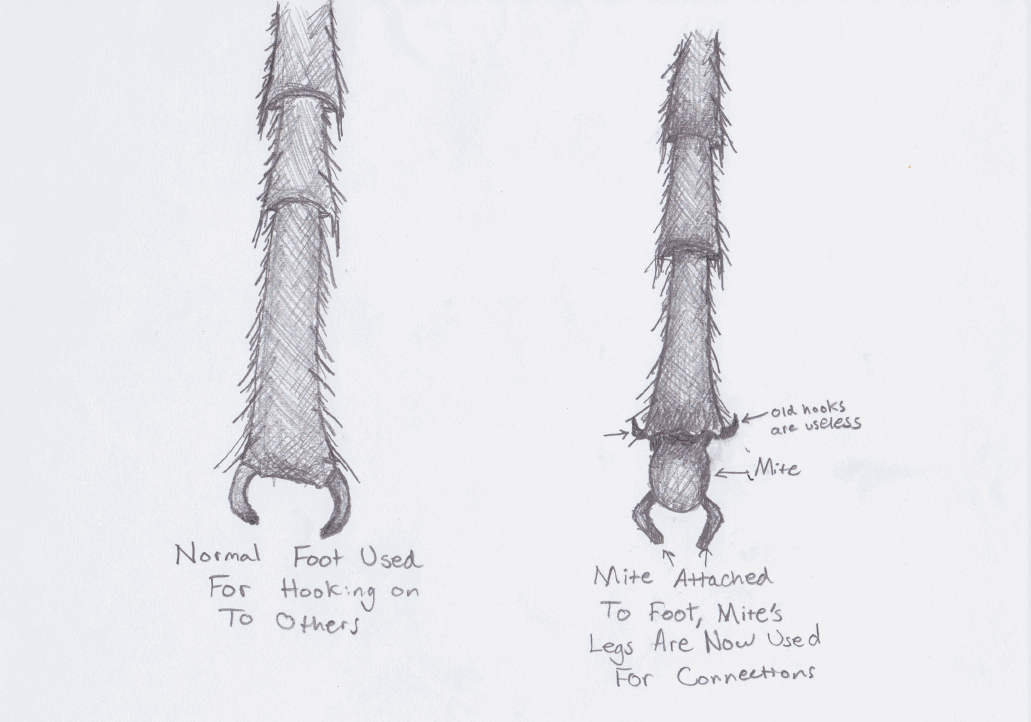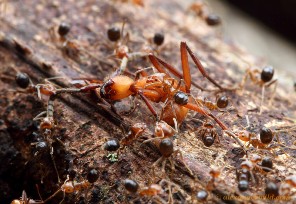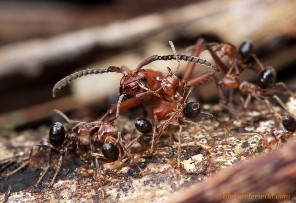Interactions
Mutualists
 Humans and ants benefit from the interactions with each other, army
ants prey upon pests that destroy crops and the ants relatives of
E. hamatum have actually been used as a agricultural pest
control in China. Army ants kill a number of pest insects throughout
the areas they inhabit and stop livestock pest such as the
screw-worm from spreading in the American-southwest. The ants are
also welcomed home guests since they can clear a house of all bugs,
beetles, cockroaches, mice, snakes, or anything else that may be
hiding in the confines of the house.
Humans and ants benefit from the interactions with each other, army
ants prey upon pests that destroy crops and the ants relatives of
E. hamatum have actually been used as a agricultural pest
control in China. Army ants kill a number of pest insects throughout
the areas they inhabit and stop livestock pest such as the
screw-worm from spreading in the American-southwest. The ants are
also welcomed home guests since they can clear a house of all bugs,
beetles, cockroaches, mice, snakes, or anything else that may be
hiding in the confines of the house.
Histerid Beetles, Pulvinister nevermanni is specific to
Eciton hamatum, rides on the major worker’s underside of the
head. These beetles climb onto the ant’s body to groom the ant to
acquire its odor so it can integrate into the colony. These beetles
feed on the dead ant brood and their prey; the ants intentionally
bring these beetles into the colony to be integrated. These beetles
are obligatory symbionts, so they need the colony to survive.
Bristletails are found with many types of army ants and are
sponsible for cleaning the workers and nests. Their primary
activities include feeding on the secretions and particles on the
surfaces of larval, pupal, and adult army ants.
Planodiscus, a mite that is exclusively phoretic on New World
army ants and typically attach themselves to the underside of the
middle or hind legs of ants. This mite mimics the legs of the ant to
avoid being taken off during grooming.

Scavengers
Phorids, humpback flies, are scavengers that follow the ants as they
migrate. The larvae of the flies feed on dead animal, plant, and
fungi material. They can be found at the ends of the migrating
columns of ants. The phorids do not actually ingrate with the ants
though but rather live at the edges of the colony. They live on dead
ants and refused prey that has been killed or wounded.
Birds also follow the army ants as they migrate and go out in search
of food. The birds are opportunistic and follow along by the
searching swarm of ants for insects to be flushed out of their
hiding places. The insects that the birds target are typically
wounded insects being attacked by the ants or any insect that
attempts to flee from the approaching mass. This relationship with
birds is most established with the ant species Labidus praedator
and Eciton burchelli of the New World ants, but is still
seen with other ant species as well such as Eciton hamatum.
Parasites
Marchocheles rettenmeyeri, is an ectoparasitic
mite that attaches itself to the hind leg pulvilli of the ant. The
mite inserts its chelicerae into the membrane of the hind leg to
hold on and feed off the hemolymph of the ant. This mite is special
because it is highly adapted for the parasitism of eciton ants. The
mite, upon attachment, serves as the new foot and lets its hind legs
act as the tarsal hooks for the ant.

Predators of Ants
Tetradonia margialis is a beetle most commonly found living
around Eciton hamatum bivouacs. These beetles are capable
of sensing the pheromone trails that the ants use to communicate and
can be in close approximation with the ants that travel on raiding
trails. These beetles usually attack any ant injured or uninjured
but the uninjured ants usually escape. These beetles catch their
prey by the hind legs and drag them away from the trails to be
separated. The main part of the ant that is fed upon is the bodily
fluids that come from the ants.
 Blind snakes, of the genus
Leptotyphlops, travel along with
and follow the army ants that they feed on. This snake can detect
and follow the trail of pheromones that the army ants use to guide
and communicate with each other. These predators are able to
integrate and travel among the groups of ants they eat without being
attacked by the ants. The snake’s ability to secrete a mixture of
feces and clear, viscous liquid repels the insects and allows them
to “blend in” among their prey. This secretion also deters other
insectivorous snakes and snake-eating snakes with which the blind
snake may want to evade. An interesting fact about this relationship
is that many indigenous people who live in close proximity to the
ant call this snake the ants cow. They reason being that this snake
is assumed to live among the ants until the ants cannot find enough
food to eat so they eat their "livestock" which they keep on hand. To check out another cool snake,
Enhydrina schistosa, click
here!
Blind snakes, of the genus
Leptotyphlops, travel along with
and follow the army ants that they feed on. This snake can detect
and follow the trail of pheromones that the army ants use to guide
and communicate with each other. These predators are able to
integrate and travel among the groups of ants they eat without being
attacked by the ants. The snake’s ability to secrete a mixture of
feces and clear, viscous liquid repels the insects and allows them
to “blend in” among their prey. This secretion also deters other
insectivorous snakes and snake-eating snakes with which the blind
snake may want to evade. An interesting fact about this relationship
is that many indigenous people who live in close proximity to the
ant call this snake the ants cow. They reason being that this snake
is assumed to live among the ants until the ants cannot find enough
food to eat so they eat their "livestock" which they keep on hand. To check out another cool snake,
Enhydrina schistosa, click
here!
 Ants as Predators
Ants as Predators
Ants also can be predators of other animals such as colonial insects
like wasps, bees, and other ants. Eciton hamatum
specializes in colony raids and acquires almost all of its food by
colony raiding.
 Snakes
and other small vertebrates also fall victim to the swarms of ants
if they are not careful. Even larger snakes such as anacondas and
pythons skeletons have been found stripped clean by the ants. The
attacks on vertebrates however are largely opportunistic seizing the
opportunity to attack caged snakes or those who have are immobilized
by consume a large animal.
Snakes
and other small vertebrates also fall victim to the swarms of ants
if they are not careful. Even larger snakes such as anacondas and
pythons skeletons have been found stripped clean by the ants. The
attacks on vertebrates however are largely opportunistic seizing the
opportunity to attack caged snakes or those who have are immobilized
by consume a large animal.
Back to
Home
Continue on to
Interesting Facts